 ®
®
For a brief intoduction to the history, try this
Potted History
Link
There is more now on our '70 Years in Music' link
 ®
®
For a brief intoduction to the history, try this
Potted History
Link
There is more now on our '70 Years in Music' link
| | has always been, and is still, owned and run by Charlie Watkins, the writer of this history. |
Profession: Able Seaman and Musical inventor. C.V: Educated by any London elementary school who would put up with me. Shook the educational fetters from my ankles at 14 and went to sea. Served throughout war. No medals or honourable wounds but learned how to play the Accordion and, more importantly, became fascinated in the structure and mechanics of the Guitar. Returned home after the war hoping to make the grade as a professional musician with only reasonable success.
1949. Opened a record shop in Tooting Market. London with brother Reg Watkins. 1951. Moved to a small shop in Balham, London and engaged in the sale of Guitars and Accordions. My fascination with the guitar, its mechanics and now its electronic reproduction paved the way to the first Watkins "Westminster" Guitar amplifiers and later the "Copicat" Echo and the "V" Fronted Dominator amplifier.
1957. Brother Reg opened a factory in Chertsey, Surrey where he designed and produced the 2nd. British made solid electric Guitar being beaten to the post by a week or two by the Dallas "Tuxedo". Joined later by brother Syd Watkins they developed the Watkins Rapier Guitars into an immediate and lasting success. They were made by the 1000 and sold all over the world.
1958. Invented the "Watkins Copicat®" Echo unit. Inspired by the "Morino Marini" Quartet of 'Comi Prima' fame. It revolutionised the world of music overnight. No printed circuit boards, just a few valves, a tape loop.......and a bit of imagination. They were sold all over the world by the hundreds of thousands and it is still regarded as the 'World Standard' in echo units. Accredited as the major element in the "Sound of the 60's" chemistry - the other components being the Vox A.C.30 and the Fender Strat. Many thousands of models are still in nightly use today after 40 years! |
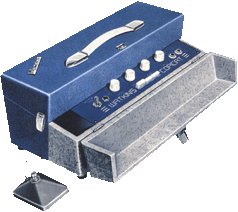 |
Despite popular belief that the preceding Mk.1 and 2 Valve Copicats® were the best performers, the facts are that this first departure from valves, the "CUSTOM COPICAT®" was by far the more successful.
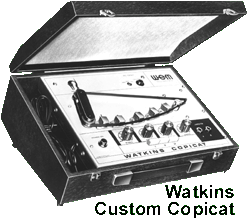
|
This was mainly because of its early transistor state of the art design
with its greater stability and greater recording bias control. It also
had, by this time, developed far superior tape transport components. |
But as an Echo Unit it outshone everything else the world had to offer. Although new digital technologies have made it possible for the unique and original Copicat sounds to be emulated and actually improved upon - nothing will ever be taken from the original pioneering 1958 Copicat - which climbed the mountain first!
|
IF YOU STILL USE TAPE LOOP COPICAT |
|
PHONE FOR OVERNIGHT SUPPLIES - +44(0)20 8679 5575 |
|
£25 for 20 Copicat Tape loops for all models - includes delivery. |
|
Credit card - Access - Visa etc |
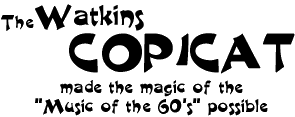
| 
|
1966. Invention of the "Slave" P.A. System. Possibly the most rewarding and personally satisfying development. In a world bristling with the likes of Alvin Lee and his Ten Years After, The Faces, Jethro Tull, Rod Stewart, Hendrix and indeed the Rolling Stones with so many brilliant groups waiting to emerge but who were unable to do so for the lack of a powerful and competent sound system. This limited the exposure of groups to small venues and pubs or whatever size a couple of lashed up Marshall 100 or Hi Watt Guitar stacks could handle.
For the next 5 or 6 years any group or Band who were serious about their sound HAD to use my WEM Slave P.A. System and they beat a path to my door. This basic system is still used universally to this day by all the P.A. producers (except that the powers are 50 time greater than mine were in those days.
WEM® P.A. made possible all of the great, early festivals. Lincoln, Shepton Mallett, Isle of Wight with Dylan in 1970, Isle of Wight with Hendrix in 1971, The immaculate "Stones in the Park" Concert with its quarter of a million audience where I mounted a mere 1500 watts but which could be heard in Edgware and is still rated, to this day, as the most exemplary and perfect sound reproduction of a modern day band. It was breathtaking.........
They started referring to me as the "Father of British P.A." a while back. That's because I'm getting on a bit. . . . I love it.
The first WEM® P.A. System with its absolutely Hi Fi quality made its first public appearance at the 1967 Windsor Festival with the help and encouragement of the brilliant Harold Pendleton, owner of London's "Marquee" Club. Suddenly artists could be HEARD with my massive P.A. System with a basic starting power in excess of 1000 watts - power unheard of since Hitler's Nuremberg rally.
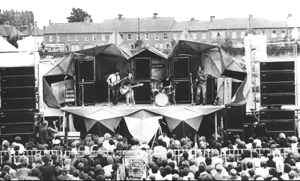
|
|
This is all that's left of the No 1. production Copicat designed for me by the brilliant Bill Purkis. It was sold to Johnny Kidd and the Pirates who queued up outside my Balham shop for one. Later, I was so keen to get this first model back to put it in my museum, or just to have it, that I offered a reward of £1000 for its return. Five years later a parcel came through the post and on opening it I found my beloved No1. Copicat and a little anonymous note "To Charlie Watkins. Thanks for 20 years of lovely music from this little Cat. Don't want your money - buy yourself a car with it!" Whoever that was, if you read this THANKS. |
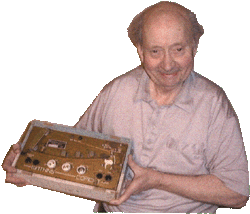 |
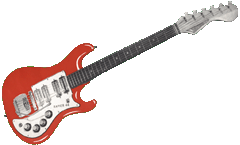
|
Designed by my brother Reg, The WATKINS "RAPIER 22" - "33" and "44" gave all of the young Brit. Guitarists a chance to "Break in on the new scene" without breaking their budget. Modestly priced between £20 and £30 these instruments were of extremely high hand made quality. They were the first guitars to incorporate the new polyester spraying technique. They left a lot of nice memories. |
This is the delectable and nostalgic WATKINS "DOMINATOR®" My theory was that it would dispense sound equally to left and right. Whether that was true or not I never found out. But nobody cared, anyway. They'd plug their Basses, Rhythm, Lead and Vocals in to its four inputs and give it some stick. This amplifier took the fancy of the day just right. Colourful, reliable and slightly spectacular with a sound that only a couple of raw EL84's in push pull can give. I used to call it 17 watts for want of a better guess. I think it was more like 15 with a theoretical potential of 17. It inspired the book "Seventeen Watts" by Mo Foster. A painstaking, textual and wholly accurate history of this era. (E-Mail me for a copy) |
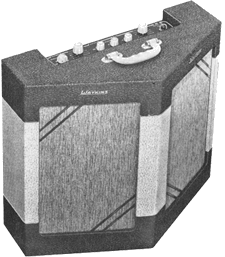 |
On the morning I announced to my sole travelling salesman that this was to be his new line he thundered. "If you think I'm going to sell a monstrous bloody thing like that!…. I'd rather sell Corn Flakes" with which he walked out and slammed the door on me. I wonder if he realised later the cost of his haste..........
I made quite a few Guitar amplifiers about this time, but the Dominator® was always the most revered. Never quite got into the big time with my Guitar combos and heads. This is probably because I lacked the expertise needed to actually play a Guitar. I'm a firm believer that he who plays Guitar can design them. He who plays an Accordion can design them - and ne'er the twain etc.
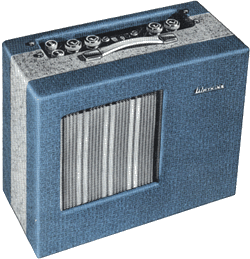
|
WATKINS "WESTMINSTER®".This was the amplifier which was good enough, and cheap enough to enable many thousands of young aspiring players to board the magic bus of the music of that day. Some of them achieving massive successes, though most having to settle for a bank of lovely memories which will never, ever, fade. |
WATKINS "JOKER®", 1963. A thirty watt 4 x EL84 amplifier with a Copicat built in - with the retractable microphone stand, 12" Hi fi driver and HF Horn it was almost a self contained sound studio. Always a very popular amplifier. Excellent characteristics and worth while building but very difficult to make. |
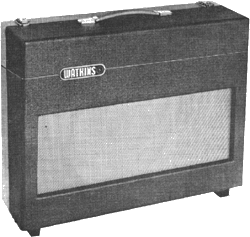 |

|
WATKINS F.R.30. The first power mixer I ever remember. My designers condemned it as intolerable madness in 1963 and the prototype spent the next three years in disgrace in my coal cellar. It re-emerged (still 5 years before its time) to become the legendary WEM "Audiomaster®" mixer which was the "live" band mixer and the accepted medium and protocol for all of the famous Festivals. If you wanted one it would cost you £65.00. |
The WATKINS FESTIVAL STACK formed what probably became the specification of today's reinforcement systems. 2 x 15" Woofer in a big pressure box. 2 x 12" in the high bass. 6 x 10" mid and hi mid range and Vitavox or Celestion Horns. I had to deliver a set of these to America for Janice Joplin and did some memorable gigs with her. But I found that the female voice needs more definition and sympathy from a cone and the heavy 15" cones were entirely unsympathetic to Janice. I replaced them with 8 x 10" Impact drivers with astounding results. Female voice ALWAYS better through a class 10".
I found, during this period 1965-1975, because of my exposure to Groups
- all of whom had different, although wholly justified, ideas about sound
in their heads. Audiences likewise who began to demand even more power
and quality at each subsequent festival and whom were not averse to punctuating
their approval or otherwise with Coke cans which, though unpleasant -
especially when full were sufferable, but the big, quart beer bottles,
one of which made a bulls eye on me in the Shepton Mallett affair of 1970
were something else and really brought you down to size.
|
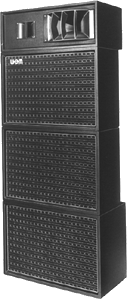 |

|
The normal 4 x 12" of the day was a lash up of 4 hard coned Guitar speakers. Then one of my designers introduced me to High Power Hi Fi and changed it all. This was the classic WEM P.A. column. Originally with the Goodmans Axiom 301 (with its massive magnet) and later with the twin coned version I designed for Rola Celestion. The sound from these columns was warm, massive and mellow. Trouble was you needed a pair to handle the 100 watts off one Slave amp. If you remember Mike Patto's TIME BOX you'll know what I mean! |
The "Slave" power amplifier was the nucleus and the basis of my interpretation of modern day Sound leading to my "Slave" invention in 1967. A transformerless RCA transistor circuit designed with simple signal in - signal out facilities. This was engaged in supplying 100 watts into 6 ohms into the correct configuration of speaker boxes. I must admit that I was greatly assisted in this configuration by both my French and my Belgian distributors - both of whom were 'entrepeneurially' astute to the point of madness. But between us we got the job done! |
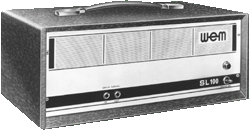 |
Nowadays, of course, they can offer up to 2000 watts of power in one amplifier, which minimises the "Slave Chain" to some extent and, of course, they are not restricted by low speaker handling powers such as we were. Having said that, I must admit that I doubt, when the chips were down, that I would have staked my commercial reputation on one, or two amplifiers however powerful - both of which could, and sometimes would break down after 70 odd hours of continuous high performance demand level.
Imagine what would have happened at the memorable "Stones in the Park" concert with its quarter of a million expectant fans if that lot had suddenly switched off. What price WEM then? The biggest act of commercial suicide I could have managed. And I would have ceased to exist. At least, with my low powered multiple Slave amps, if one or two had packed up - for whatever reason then there were plenty left to fill the hole.
As it happens only on one occasion did I have to face any fault with the WEM Slave amplifiers and they would burn from the start of the festival, full belt until the end. That was on the occasion of Edgar Broughton's appearance at one of the Hyde Park concerts. A French T.V. Audio journalist decided to get a live, first hand recording of Broughton's set by grafting one of his French splitter cables into my series of sweetly burning Slaves and finished up with a massive 60 cycle roar in the middle of Edgar's "Out, Demons, Out." Afraid it was a case of "In Demons, In." Anyway, Edgar, being the absolute unflappable character that he was got rid of the red face problem when I got rid of the miscreant journalist and his weird cable, by teasing my discomfiture and pulling my leg to the delight of the thousands in front. I finished up being quite pleased about the near disaster.
Then, of course, there was the absolutely fearful night at London's "Marquee Club" when we were demonstrating the invincibility of our WEM P.A. to "The Cream" in the hope they would buy one. Eight of my Slaves were linked up backstage, and you know how those areas get with all the "friends" leaping around. Well, one of them shorted one of my slave links in the middle of one of Bruce's songs. Everything went dead. He went livid. I went berserk. And it was five minutes before I found the fault. When I remedied the matter Bruce took great pleasure in giving the whole of the audience a lecture about Never, Ever, going for a WEM P.A. - Even demanding that I turn my own volume up all the better for his harangue and his massive denunciation of me and all I stood for to reach their ears.
It was where I learned that if you're doing a job and something goes wrong, for whatever reason and whoever's fault it is YOU are responsible, and that's the end of it. And you don't start bitching and whining. Happily a few months after "The Cream's" last stupendous appearance at the Albert Hall to mark their retirement, they specified me and my WEM P.A. to support them. Videos of that great concert are still replayed and the publicity has been worth a fortune. Same as "Stones in the Park" - on the telly nearly every week with me on the stage waving my arms above for no logical reason other than to be noticed I suppose.
The most Slaves I ever used was 50 (5000 watts of them) joined together at the Grangemouth Festival of 1973. This was the only festival I didn't enjoy. I was becoming dis-enchanted, anyway, at the way the festival scene had deteriorated since its beautiful early days. Bands were excessively demanding, multiplying by at least two the power requirements of last year's P.A. for this year regardless of the hazards and technical problems which lay ahead for the likes of me. And when (at Grangemouth) a distraught young man ran from the audience throng appealing, "There's a guy in there with a knife, Sir. Can you do anything?" It was just about the last straw.
At the Isle of Wight Festival which sported Jimi Hendrix, promoters "Fiery Creations" and Rikki Farr were forced, by the knowledgeable powers that be, to hold their festival on the top of a hill with an almost permanent prevailing wind towards the stage (which would severely affect our sound performance, making it impossible to gain any velocity. Try as I did I soon found there is no power like the power of nature and the sound finished up better to the rear of the stage than to the front where the audience was.
Thanks to all that aggravation plus the violence of, it was claimed, the Algerian "Festivals should be Free" contingent I finished up like this after three days and nights non stop effort, a collapse from nervous exhaustion and feeling it all so personally that all those lovely groups had disappointing performances, because, I ill-advisedly decided in my trauma, of my inadequacy - a self inflicted criticism which I later, and still do, utterly repudiate.
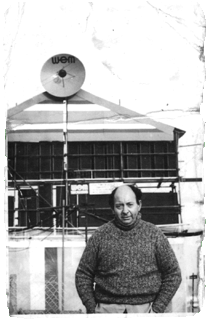
|
That WEM® P.A. System with my newly designed parabolic focusable
reflector which, although only powered by a single Goodmans R101 10" 10
watt driver could send 1KH to 3KH for a distance of 5 miles in reasonable
conditions.
|
Speak to somebody ? Phone 020 8679 5575.